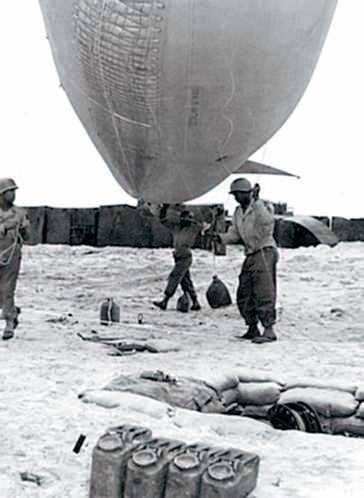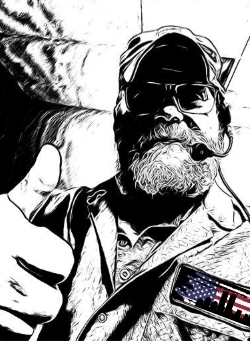via: U.S. Army Special Operations Aviation Command
·
Interesting aviation related Black History month story, and maybe the prelude to modern-day UAS!
There were many heroes and heroic sagas during World War II. But, many heroic actions received little or no recognition because the American Army was segregated; and the Soldiers and their units were black.
One such all-black unit was the 320th Very Low Altitude barrage balloon battalion. The battalion was raised up in 1942 just a year after the Coastal Artillery Corps took over responsibility for barrage balloons from the Army Air Corps.
"The 320th VLA was the only black combat unit to take part in the D-Day landings and was the only barrage balloon battalion to land on the beaches. Units from the 320th landed on both Omaha and Utah beaches and, if you look at pictures of the D-Day beachhead and you see barrage balloons there, they were manned by three to five black troops from the 320th," said Jonathan Bernstein, Army Air Defense Artillery Museum director here. "The first Soldiers from the battalion landed on Omaha Beach at 9 a.m., two hours after the invasion began. The first balloon was floated at 11:15 p.m. that night, and by the next day all of their balloons were knocked out by German artillery fire. But, they were resupplied and were able to quickly float new balloons."
·
Interesting aviation related Black History month story, and maybe the prelude to modern-day UAS!
There were many heroes and heroic sagas during World War II. But, many heroic actions received little or no recognition because the American Army was segregated; and the Soldiers and their units were black.
One such all-black unit was the 320th Very Low Altitude barrage balloon battalion. The battalion was raised up in 1942 just a year after the Coastal Artillery Corps took over responsibility for barrage balloons from the Army Air Corps.
"The 320th VLA was the only black combat unit to take part in the D-Day landings and was the only barrage balloon battalion to land on the beaches. Units from the 320th landed on both Omaha and Utah beaches and, if you look at pictures of the D-Day beachhead and you see barrage balloons there, they were manned by three to five black troops from the 320th," said Jonathan Bernstein, Army Air Defense Artillery Museum director here. "The first Soldiers from the battalion landed on Omaha Beach at 9 a.m., two hours after the invasion began. The first balloon was floated at 11:15 p.m. that night, and by the next day all of their balloons were knocked out by German artillery fire. But, they were resupplied and were able to quickly float new balloons."
via: U.S. Army Special Operations Aviation Command
·
Interesting aviation related Black History month story, and maybe the prelude to modern-day UAS!
There were many heroes and heroic sagas during World War II. But, many heroic actions received little or no recognition because the American Army was segregated; and the Soldiers and their units were black.
One such all-black unit was the 320th Very Low Altitude barrage balloon battalion. The battalion was raised up in 1942 just a year after the Coastal Artillery Corps took over responsibility for barrage balloons from the Army Air Corps.
"The 320th VLA was the only black combat unit to take part in the D-Day landings and was the only barrage balloon battalion to land on the beaches. Units from the 320th landed on both Omaha and Utah beaches and, if you look at pictures of the D-Day beachhead and you see barrage balloons there, they were manned by three to five black troops from the 320th," said Jonathan Bernstein, Army Air Defense Artillery Museum director here. "The first Soldiers from the battalion landed on Omaha Beach at 9 a.m., two hours after the invasion began. The first balloon was floated at 11:15 p.m. that night, and by the next day all of their balloons were knocked out by German artillery fire. But, they were resupplied and were able to quickly float new balloons."
0 Comentários
0 Compartilhamentos
42071 Visualizações















